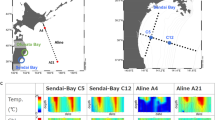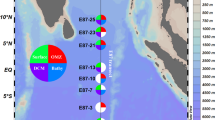Abstract
Microbial gene expression in the environment has recently been assessed via pyrosequencing of total RNA extracted directly from natural microbial assemblages. Several such ‘metatranscriptomic’ studies1,2 have reported that many complementary DNA sequences shared no significant homology with known peptide sequences, and so might represent transcripts from uncharacterized proteins. Here we report that a large fraction of cDNA sequences detected in microbial metatranscriptomic data sets are comprised of well-known small RNAs (sRNAs)3, as well as new groups of previously unrecognized putative sRNAs (psRNAs). These psRNAs mapped specifically to intergenic regions of microbial genomes recovered from similar habitats, displayed characteristic conserved secondary structures and were frequently flanked by genes that indicated potential regulatory functions. Depth-dependent variation of psRNAs generally reflected known depth distributions of broad taxonomic groups4, but fine-scale differences in the psRNAs within closely related populations indicated potential roles in niche adaptation. Genome-specific mapping of a subset of psRNAs derived from predominant planktonic species such as Pelagibacter revealed recently discovered as well as potentially new regulatory elements. Our analyses show that metatranscriptomic data sets can reveal new information about the diversity, taxonomic distribution and abundance of sRNAs in naturally occurring microbial communities, and indicate their involvement in environmentally relevant processes including carbon metabolism and nutrient acquisition.
This is a preview of subscription content, access via your institution
Access options
Subscribe to this journal
Receive 51 print issues and online access
$199.00 per year
only $3.90 per issue
Buy this article
- Purchase on Springer Link
- Instant access to full article PDF
Prices may be subject to local taxes which are calculated during checkout




Similar content being viewed by others
Accession codes
Data deposits
The sequences reported here have been deposited in GenBank under accession numbers SRA007802.3, SRA000263, SRA007804.3 and SRA007806.3 corresponding to cDNA sequences, and SRA007801.5, SRA000262, SRA007803.3 and SRA007805.4 corresponding to DNA sequences, for 25 m, 75 m, 125 m and 500 m samples, respectively.
References
Frias-Lopez, J. et al. Microbial community gene expression in ocean surface waters. Proc. Natl Acad. Sci. USA 105, 3805–3810 (2008)
Gilbert, J. A. et al. Detection of large numbers of novel sequences in the metatranscriptomes of complex marine microbial communities. PLoS ONE 3, e3042 (2008)
Storz, G. & Haas, D. A guide to small RNAs in microorganisms. Curr. Opin. Microbiol. 10, 93–95 (2007)
DeLong, E. F. et al. Community genomics among stratified microbial assemblages in the ocean’s interior. Science 311, 496–503 (2006)
Gottesman, S. Stealth regulation: biological circuits with small RNA switches. Genes Dev. 16, 2829–2842 (2002)
Lenz, D. H. et al. The small RNA chaperone Hfq and multiple small RNAs control quorum sensing in Vibrio harveyi and Vibrio cholerae . Cell 118, 69–82 (2004)
Duehring, U., Axmann, I. M., Hess, W. R. & Wilde, A. An internal antisense RNA regulates expression of the photosynthesis gene isiA . Proc. Natl Acad. Sci. USA 103, 7054–7058 (2006)
Steglich, C. et al. The challenge of regulation in a minimal photoautotroph: non-coding RNAs in Prochlorococcus . PLoS Genet. 4, e1000173 (2008)
Vogel, J. et al. RNomics in Escherichia coli detects new sRNA species and indicates parallel transcriptional output in bacteria. Nucleic Acids Res. 31, 6435–6443 (2003)
Silvaggi, J. M., Perkins, J. B. & Losick, R. Genes for small, noncoding RNAs under sporulation control in Bacillus subtilis . J. Bacteriol. 188, 532–541 (2006)
Karl, D. M. & Lukas, R. The Hawaii Ocean Time-series (HOT) program: Background, rationale and field implementation. Deep-Sea Res. II 43, 129–156 (1996)
Kawano, M., Reynolds, A. A., Miranda-Rios, J. & Storz, G. Detection of 5′- and 3′-UTR-derived small RNAs and cis-encoded antisense RNAs in Escherichia coli . Nucleic Acids Res. 33, 1040–1050 (2005)
Eddy, S. INFERNAL User’s Guide, Version 0. 72 〈http://infernal.janelia.org/〉 (2007)
Griffiths-Jones, S. et al. Rfam: annotating non-coding RNAs in complete genomes. Nucleic Acids Res. 33, D121–D124 (2005)
Brantl, S. Bacterial gene regulation: from transcription attenuation to riboswitches and ribozymes. Trends Microbiol. 12, 473–475 (2004)
Schattner, P. Searching for RNA genes using base-composition statistics. Nucleic Acids Res. 30, 2076–2082 (2002)
Ré, M. & Pavesi, G. in Applications of Fuzzy Sets Theory (eds Masulli, F., Mitra, S. & Pasi, G.) 544–550 (Springer, 2007)
Konstantinidis, K. T. & DeLong, E. F. Genomic patterns of recombination, clonal divergence and environment in marine microbial populations. ISME J. 2, 1052–1065 (2008)
Rusch, D. B. et al. The Sorcerer II Global Ocean Sampling expedition: Northwest Atlantic through eastern tropical Pacific. PLoS Biol. 5, 398–431 (2007)
Vogel, J. & Wagner, E. G. H. Target identification of small noncoding RNAs in bacteria. Curr. Opin. Microbiol. 10, 262–270 (2007)
Hershberg, R., Altuvia, S. & Margalit, H. A survey of small RNA-encoding genes in Escherichia coli . Nucleic Acids Res. 31, 1813–1820 (2003)
Yao, Z. et al. A computational pipeline for high-throughput discovery of cis-regulatory noncoding RNA in prokaryotes. PLoS Comp. Biol. 3, 1212–1223 (2007)
Trotochaud, A. E. & Wassarman, K. M. A highly conserved 6S RNA structure is required for regulation of transcription. Nature Struct. Mol. Biol. 12, 313–319 (2005)
Bruttin, A. & Brüssow, H. Site-specific spontaneous deletions in three genome regions of a temperate Streptococcus thermophilus phage. Virology 219, 96–104 (1996)
Abreu-Goodger, C. & Merino, E. RibEx: a web server for locating riboswitches and other conserved bacterial regulatory elements. Nucleic Acids Res. 33, W690–W692 (2005)
Martiny, A. C., Coleman, M. L. & Chisholm, S. W. Phosphate acquisition genes in Prochlorococcus ecotypes: evidence for genome-wide adaptation. Proc. Natl Acad. Sci. USA 103, 12552–12557 (2006)
Tripp, H. J. et al. Unique glycine-activated riboswitch linked to glycine-serine auxotrophy in SAR11. Environ. Microbiol. 11, 230–238 (2008)
Hofacker, I. L. Vienna RNA secondary structure server. Nucleic Acids Res. 31, 3429–3431 (2003)
Washietl, S., Hofacker, I. L. & Stadler, P. F. Fast and reliable prediction of noncoding RNAs. Proc. Natl Acad. Sci. USA 102, 2454–2459 (2005)
Wendisch, V. F. et al. Isolation of Escherichia coli mRNA and comparison of expression using mRNA and total RNA on DNA microarrays. Anal. Biochem. 290, 205–213 (2001)
Vangelder, R. N. et al. Amplified RNA synthesized from limited quantities of heterogeneous cDNA. Proc. Natl Acad. Sci. USA 87, 1663–1667 (1990)
Margulies, M. et al. Genome sequencing in microfabricated high-density picolitre reactors. Nature 437, 376–380 (2005)
Altschul, S. F., Gish, W., Miller, W., Myers, E. W. & Lipman, D. J. Basic local alignment search tool. J. Mol. Biol. 215, 403–410 (1990)
Eddy, S. R. & Durbin, R. RNA sequence-analysis using covariance-models. Nucleic Acids Res. 22, 2079–2088 (1994)
Rudd, K. E. EcoGene: a genome sequence database for Escherichia coli K-12. Nucleic Acids Res. 28, 60–64 (2000)
Huson, D. H., Auch, A. F., Qi, J. & Schuster, S. C. MEGAN analysis of metagenomic data. Genome Res. 17, 377–386 (2007)
Edgar, R. C. MUSCLE: multiple sequence alignment with high accuracy and high throughput. Nucleic Acids Res. 32, 1792–1797 (2004)
Holste, D., Weiss, O., Grosse, I. & Herzel, H. Are noncoding sequences of Rickettsia prowazekii remnants of “neutralized” genes? J. Mol. Evol. 51, 353–362 (2000)
Mincer, T. J. et al. Quantitative distribution of presumptive archaeal and bacterial nitrifiers in Monterey Bay and the North Pacific subtropical gyre. Environ. Microbiol. 9, 1162–1175 (2007)
Livak, K. J. & Schmittgen, T. D. Analysis of relative gene expression data using real-time quantitative PCR and the 2-[Delta][Delta]CT Method. Methods 25, 402–408 (2001)
Noguchi, H., Park, J. & Takagi, T. MetaGene: prokaryotic gene finding from environmental genome shotgun sequences. Nucleic Acids Res. 34, 5623–5630 (2006)
Kanehisa, M. & Goto, S. KEGG: Kyoto encyclopedia of genes and genomes. Nucleic Acids Res. 28, 27–30 (2000)
Tatusov, R. L., Galperin, M. Y., Natale, D. A. & Koonin, E. V. The COG database: a tool for genome-scale analysis of protein functions and evolution. Nucleic Acids Res. 28, 33–36 (2000)
Hofacker, I. L., Fekete, M. & Stadler, P. F. Secondary structure prediction for aligned RNA sequences. J. Mol. Biol. 319, 1059–1066 (2002)
Axmann, I. M. et al. Identification of cyanobacterial non-coding RNAs by comparative genome analysis. Genome Biol. 6, R73 (2005)
Jason, S. & Ewan, B. The Bioperl project: motivation and usage. SIGBIO Newsl. 20, 13–14 (2000)
Acknowledgements
We are grateful to the University of Hawaii HOT team, and the captain and crew of the RV Kilo Moana for their expert assistance at sea. We also thank S. Schuster for collaboration and advice on pyrosequencing, J. Eppley for help with computational analyses and discussion, and J. Maresca, A. Martinez, J. McCarren and V. Rich for their comments on this manuscript. We thank S. Giovannoni, J. Tripp and M. Schwalbach for sharing their in press manuscript on Pelagibacter riboswitches, and S. Giovannoni, U. Stingl, the J. Craig Venter Institute and the Gordon and Betty Moore Foundation for the genome sequence of Pelagibacter strain HTCC7211. This work was supported by the Gordon and Betty Moore Foundation, National Science Foundation Microbial Observatory Award MCB-0348001, the Department of Energy Genomics GTL Program, the Department of Energy Microbial Genomics Program, and an NSF Science and Technology award, C-MORE. This article is a contribution from the NSF Science and Technology Center for Microbial Oceanography: Research and Education (C-MORE).
Author Contributions E.F.D. conceived and directed the research, coordinated the sequencing effort and collected the samples. Y.S. prepared samples for sequencing, and made the initial observation of sRNA sequences. E.F.D., Y.S. and G.W.T. developed the concept of the paper together. Y.S. and G.W.T. performed the data analysis. Y.S. wrote the first draft of the paper, which was completed by G.W.T. and E.F.D. together.
Author information
Authors and Affiliations
Corresponding author
Supplementary information
Supplementary Information
This file contains Supplementary Figures 1-6 with Legends, Supplementary Tables 1-3 and Supplementary References. (PDF 5587 kb)
Rights and permissions
About this article
Cite this article
Shi, Y., Tyson, G. & DeLong, E. Metatranscriptomics reveals unique microbial small RNAs in the ocean’s water column. Nature 459, 266–269 (2009). https://doi.org/10.1038/nature08055
Received:
Accepted:
Issue Date:
DOI: https://doi.org/10.1038/nature08055
This article is cited by
-
Soil microbial ecology through the lens of metatranscriptomics
Soil Ecology Letters (2024)
-
‘Multi-omics’ data integration: applications in probiotics studies
npj Science of Food (2023)
-
Meta-omics approaches reveal unique small RNAs exhibited by the uncultured microorganisms dwelling deep-sea hydrothermal sediment in Guaymas Basin
Archives of Microbiology (2022)
-
Integration of absolute multi-omics reveals dynamic protein-to-RNA ratios and metabolic interplay within mixed-domain microbiomes
Nature Communications (2020)
Comments
By submitting a comment you agree to abide by our Terms and Community Guidelines. If you find something abusive or that does not comply with our terms or guidelines please flag it as inappropriate.



